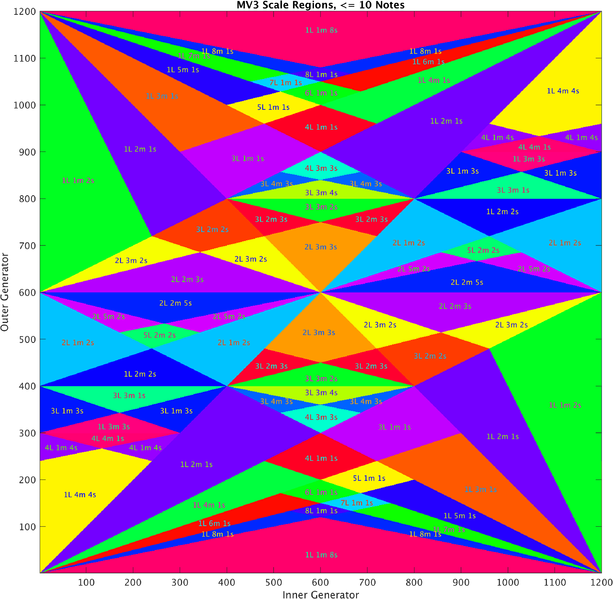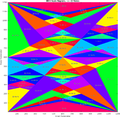File:MV3-Labeled.png

Original file (2,793 × 2,730 pixels, file size: 294 KB, MIME type: image/png)
Summary
Given two generators, we can repeatedly stack those generators in alternating sequence until we arrive at a max-variety-3 or "MV3 scale" in which each interval class is in at most three (and sometimes exactly) three sizes.
Each pair of generators forms a sequence of MV3 scales, and we can look at the largest MV3 scale generated that is less than some number of notes (in this situation the max is 10). Given all possible pairs of generators, we can compute this largest at-most-10-note MV3 scale and see which regions generate the same scales, and at which points the generators flip to generating a different scale.
This picture is a "map" showing these regions. The (x, y) coordinates represent the two generators (in cents), with a twist: the x coordinate represents the "inner generator," and the y coordinate represents the "outer generator." So for instance, if we are alternating the two generators 386 and 316 cents, this would be represented using the coordinate (386, 702), with the second coordinate being the sum of the two alternating generators. (This nested-generator view is perhaps more useful than the "alternating generator" view, such as for instances where you may want to iterate the inner generator more than once within the outer generator before iterating the outer generator).
For each pair of generators, we compute the largest MV3 scale that is <= 10 notes. Given that scale's step-size pattern (like 3L2m2s), we derive a unique randomly-assigned color. We then assign that color to all points which generate that particular scale as the largest below 10 notes. The lines in this diagram seem to have simple rational slopes and correspond to situations where the generators are not linearly independent (which often means MOS, or something close to it). The vertices of these regions seem to correspond to when the generators are tuned to some simple equal temperament.
File history
Click on a date/time to view the file as it appeared at that time.
| Date/Time | Thumbnail | Dimensions | User | Comment | |
|---|---|---|---|---|---|
| current | 02:09, 28 May 2022 |  | 2,793 × 2,730 (294 KB) | Mike Battaglia (talk | contribs) | Given two generators, we can repeatedly stack those generators in alternating sequence until we arrive at a max-variety-3 or "MV3 scale" in which each interval class is in at most three (and sometimes exactly) three sizes. Each pair of generators forms a sequence of MV3 scales, and we can look at the largest MV3 scale generated that is less than some number of notes (in this situation the max is 10). Given all possible pairs of generators, we can compute this largest at-most-10-note MV3 scal... |
You cannot overwrite this file.
File usage
The following page uses this file: